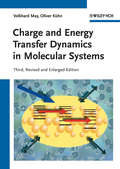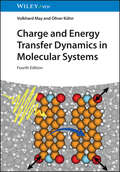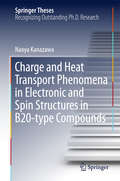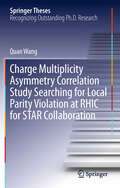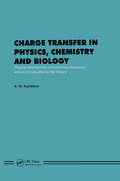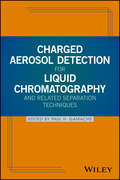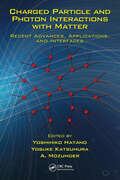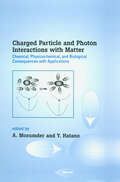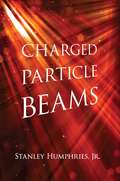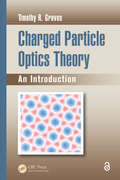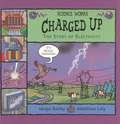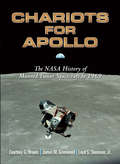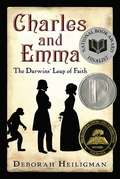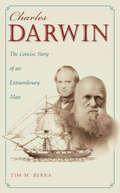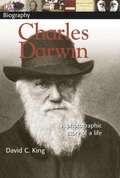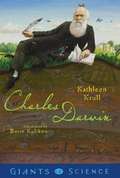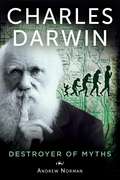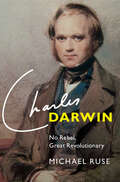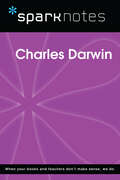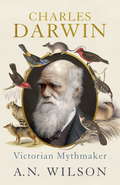- Table View
- List View
Charge and Energy Transfer Dynamics in Molecular Systems: A Theoretical Introduction
by Volkhard May Oliver KühnThis 3rd edition has been expanded and updated to account for recent developments, while new illustrative examples as well as an enlarged reference list have also been added. It naturally retains the successful concept of its predecessors in presenting a unified perspective on molecular charge and energy transfer processes, thus bridging the regimes of coherent and dissipative dynamics, and establishing a connection between classic rate theories and modern treatments of ultrafast phenomena. Among the new topics are: - Time-dependent density functional theory - Heterogeneous electron transfer, e.g. between molecules and metal or semiconductor surfaces - Current flows through a single molecule. While serving as an introduction for graduate students and researchers, this is equally must-have reading for theoreticians and experimentalists, as well as an aid to interpreting experimental data and accessing the original literature.
Charge and Energy Transfer Dynamics in Molecular Systems
by Volkhard May Oliver KühnCharge and Energy Transfer Dynamics in Molecular Systems Comprehensive resource offering knowledge on charge and energy transfer dynamics in molecular systems and nanostructures Charge and Energy Transfer Dynamics in Molecular Systems provides a unified description of different charge and energy transfer phenomena in molecular systems with emphasis on the theory, bridging the regimes of coherent and dissipative dynamics and thus presenting classic rate theories as well as modern treatments of ultrafast phenomena. Starting from microscopic models, the common features of the different transfer processes are highlighted, along with applications ranging from vibrational energy flow in large polyatomic molecules, the motion of protons in solution, up to the concerted dynamics of electronic and nuclear degrees of freedom in molecules and molecular aggregates. The newly revised and updated Fourth Edition contains a more detailed coverage of recent developments in density matrix theory, mixed quantum-classical methods for dynamics simulations, and a substantially expanded treatment of time-resolved spectroscopy. The book is written in an easy-to-follow style, including detailed mathematical derivations, thus making even complex concepts understandable and applicable. Charge and Energy Transfer Dynamics in Molecular Systems includes information on: Electronic and vibrational molecular states, covering molecular Schrödinger equation, Born—Oppenheimer separation and approximation, Hartree-Fock equations and other electronic structure methods Dynamics of isolated and open quantum systems, covering multidimensional wave packet dynamics, and different variants of density operator equations Interaction of molecular systems with radiation fields, covering linear and nonlinear optical response using the correlation function approach Intramolecular electronic transitions, covering optical transition and internal conversion processes Transfer processes of electrons, protons, and electronic excitation energy Providing in-depth coverage of the subject, Charge and Energy Transfer Dynamics in Molecular Systems is an essential resource for anyone working on timely problems of energy and charge transfer in physics, chemistry and biophysics as well as for all engaged in nanoscience and organic electronics.
Charge and Heat Transport Phenomena in Electronic and Spin Structures in B20-type Compounds (Springer Theses)
by Naoya KanazawaThis thesis presents systematic experimental research on chiral-lattice crystals referred to as B20-type germanium compounds, especially focusing on skyrmion spin textures and Dirac electrons. An emergent electromagnetic field observed in MnGe demonstrates a formation of three-dimensional skyrmion crystals. Detection of skyrmions in nanoscale Hall bar devices made of FeGe is realized by measuring the topological Hall effect, a transport property reflecting emergent fields produced by skyrmions. By measuring the electron-filling dependence of thermopower in CoGe, a pronounced thermoelectric property in this compound is revealed to stem from the asymmetric density of states appearing at certain levels of Fermi energy in the Dirac electron state. The three main results named above will contribute to enriching a variety of novel electromagnetic responses of emergent gauge fields in solids, to realizing high-performance skyrmion-based magnetic memory, and to designing high-efficiency thermoelectric materials, respectively.
Charge and Spin Transport in Disordered Graphene-Based Materials (Springer Theses)
by Dinh TuanThis thesis presents an in-depth theoretical analysis of charge and spin transport properties in complex forms of disordered graphene. It relies on innovative real space computational methods of the time-dependent spreading of electronic wave packets. First a universal scaling law of the elastic mean free path versus the average grain size is predicted for polycrystalline morphologies, and charge mobilities of up to 300. 000 cm2/V. s are determined for 1 micron grain size, while amorphous graphene membranes are shown to behave as Anderson insulators. An unprecedented spin relaxation mechanism, unique to graphene and driven by spin/pseudospin entanglement is then reported in the presence of weak spin-orbit interaction (gold ad-atom impurities) together with the prediction of a crossover from a quantum spin Hall Effect to spin Hall effect (for thallium ad-atoms), depending on the degree of surface ad-atom segregation and the resulting island diameter.
Charge Multiplicity Asymmetry Correlation Study Searching for Local Parity Violation at RHIC for STAR Collaboration (Springer Theses)
by Quan WangIt has been suggested that local parity violation (LPV) in Quantum Chromodynamics (QCD) would lead to charge separation of quarks by the Chiral Magnetic Effect (CME) in heavy ion collisions. Charge Multiplicity Asymmetry Correlation Study Searching for Local Parity Violation at RHIC for STAR Collaboration presents the detailed study of charge separation with respect to the event plane. Results on charge multiplicity asymmetry in Au+Au and d+Au collisions at 200 GeV by the STAR experiment are reported. It was found that the correlation results could not be explained by CME alone. Additionally, the charge separation signal as a function of the measured azimuthal angle range as well as the event-by-event anisotropy parameter are studied. These results indicate that the charge separation effect appears to be in-plane rather than out-of-plane. It is discovered that the charge separation effect is proportional to the event-by-event azimuthal anisotropy and consistent with zero in events with zero azimuthal anisotropy. These studies suggest that the charge separation effect, within the statistical error, may be a net effect of event anisotropy and correlated particle production. A potential upper limit on the CME is also presented through this data.
Charge Quantization and Kondo Quantum Criticality in Few-Channel Mesoscopic Circuits (Springer Theses)
by Zubair IftikharThis thesis explores several fundamental topics in mesoscopic circuitries that incorporate few electronic conduction channels. It reports a series of long-awaited experiments that establish a new state of the art. The first experiments address the quantized character of charge in circuits. We demonstrate the charge quantization criterion, observe the predicted charge quantization scaling and a crossover toward a universal behavior as temperature is increased. The second set of experiments addresses the unconventional quantum critical physics that arises in the multichannel Kondo model. We observe the predicted universal Kondo fixed points and validate the numerical renormalization group scaling curves. Away from the quantum critical point, we obtain a direct visualization of the development of a second-order quantum phase transition.
Charge Transfer in Physics, Chemistry and Biology: Physical Mechanisms of Elementary Processes and an Introduction to the Theory
by A.M. KuznetrsovThis book covers the various processes of charge transfer in physics, chemistry and biology and shows the similarities and differences between them. It focuses on the physical mechanisms of the elementary processes to demonstrate their common physical nature.
Charged Aerosol Detection for Liquid Chromatography and Related Separation Techniques
by Paul H. GamacheThe first book devoted exclusively to a highly popular, relatively new detection technique Charged Aerosol Detection for Liquid Chromatography and Related Separation Techniques presents a comprehensive review of CAD theory, describes its advantages and limitations, and offers extremely well-informed recommendations for its practical use. Using numerous real-world examples based on contributors’ professional experiences, it provides priceless insights into the actual and potential applications of CAD across a wide range of industries. Charged aerosol detection can be combined with a variety of separation techniques and in numerous configurations. While it has been widely adapted for an array of industrial and research applications with great success, it is still a relatively new technique, and its fundamental performance characteristics are not yet fully understood. This book is intended as a tool for scientists seeking to identify the most effective and efficient uses of charged aerosol detection for a given application. Moving naturally from basic to advanced topics, the author relates fundamental principles, practical uses, and applications across a range of industrial settings, including pharmaceuticals, petrochemicals, biotech, and more. Offers timely, authoritative coverage of the theory, experimental techniques, and end-user applications of charged aerosol detection Includes contributions from experts from various fields of applications who explore CAD’s advantages over traditional HPLC techniques, as well its limitations Provides a current theoretical and practical understanding of CAD, derived from authorities on aerosol technology and separation sciences Features numerous real-world examples that help relate fundamental properties and general operational variables of CAD to its performance in a variety of conditions Charged Aerosol Detection for Liquid Chromatography and Related Separation Techniques is a valuable resource for scientists who use chromatographic techniques in academic research and across an array of industrial settings, including the biopharmaceutical, biotechnology, biofuel, chemical, environmental, and food and beverage industries, among others.
Charged Particle and Photon Interactions with Matter: Recent Advances, Applications, and Interfaces
by Yoshihiko Hatano Yosuke Katsumura A. MozumderBuilding on Mozumder's and Hatano's Charged Particle and Photon Interactions with Matter: Chemical, Physicochemical, and Biological Consequences with Applications (CRC Press, 2004), Charged Particle and Photon Interactions with Matter: Recent Advances, Applications, and Interfaces expands upon the scientific contents of the previous volume by cover
Charged Particle and Photon Interactions with Matter: Chemical, Physicochemical, and Biological Consequences with Applications
by A. Mozumder Y. HatanoCharged Particle and Photon Interactions with Matter offers in-depth perspectives on phenomena of ionization and excitation induced by charged particle and photon interactions with matter in vivo and in vitro. This reference probes concepts not only in radiation and photochemistry, but also in radiation physics, radiation biochemistry, and radiatio
Charged Particle Beams (Dover Books On Physics Series)
by Stanley Humphries Jr.Detailed enough for a text and sufficiently comprehensive for a reference, this volume addresses topics vital to understanding high-power accelerators and high-brightness-charged particle beams. Subjects include stochastic cooling, high-brightness injectors, and the free electron laser. Humphries provides students with the critical skills necessary for the problem-solving insights unique to collective physics problems. 1990 edition.
Charged Particle Optics Theory: An Introduction (Optical Sciences and Applications of Light #1)
by Timothy R. GrovesCharged Particle Optics Theory: An Introduction identifies the most important concepts of charged particle optics theory, and derives each mathematically from the first principles of physics. Assuming an advanced undergraduate-level understanding of calculus, this book follows a logical progression, with each concept building upon the preceding one. Beginning with a non-mathematical survey of the optical nature of a charged particle beam, the text:Discusses both geometrical and wave optics, as well as the correspondence between themDescribes the two-body scattering problem, which is essential to the interaction of a fast charged particle with matterIntroduces electron emission as a practical consequence of quantum mechanicsAddresses the Fourier transform and the linear second-order differential equationIncludes problems to amplify and fill in the theoretical details, with solutions presented separatelyCharged Particle Optics Theory: An Introduction makes an ideal textbook as well as a convenient reference on the theoretical origins of the optics of charged particle beams. It is intended to prepare the reader to understand the large body of published research in this mature field, with the end result translated immediately to practical application.
Charged Up: The Story Of Electricity (Science Works)
by Jacqui BaileyDescribes how electrical energy is generated in power stations and how it travels through pylons, power cables, and wires into people's homes.
Chariots for Apollo: The NASA History of Manned Lunar Spacecraft to 1969 (Dover Books on Astronomy)
by Courtney G. Brooks James M. Grimwood Loyd S. Swenson Jr.Millions around the world watched as the Apollo 11 astronauts "came in peace for all mankind" to take humanity's first steps on the moon. Their mission's triumph was equally attributable to a less visible crew of nearly 400,000 people in hundreds of different organizations. This official NASA history reveals the human story behind an epic achievement. Written by a trio of experts, it chronicles the engineering and management contributions to the success of Project Apollo, starting with the creation of NASA itself and tracing the design and development of the project's spacecraft and lunar vehicles as well as their operation in space.Refreshingly free of jargon and technical language, this accessible account focuses on the coordination of efforts behind the production of the Apollo service, command, and lunar modules. It covers three phases of spacecraft evolution: defining and designing the necessary vehicles; developing and qualifying them for the task; and operating them to achieve their objectives. The authors conducted numerous interviews with the project's participants and relied heavily on NASA's extensive archives. In addition to several appendixes, the text is supplemented with more than 100 photographs and illustrations that recapture the efforts of the dedicated team of thousands who reached for the moon.
Charles and Emma (The Darwins' Leap of Faith)
by Deborah HeiligmanCharles Darwin published "The Origin of Species", his revolutionary tract on evolution and the fundamental ideas involved, in 1859. 150 years later, the theory of evolution continues to create tension between the scientific and religious communities. This same debate raged within Darwin himself, and played an important part in his marriage: his wife, Emma, was very religious, and her faith challenged Charles as he worked on his theory of evolution.
Charles Darwin: The Concise Story of an Extraordinary Man
by Tim M. BerraTwo hundred years after Charles Darwin's birth (February 12, 1809), this thoroughly illustrated, yet concise biography reveals the great scientist as husband, father, and friend. Tim M. Berra, whose "Darwin: The Man" lectures are in high demand worldwide, tells the fascinating story of the person and the idea that changed everything. Berra discusses Darwin’s revolutionary scientific work, its impact on modern-day biological science, and the influence of Darwin’s evolutionary theory on Western thought. But Berra digs deeper to reveal Darwin the man by combining anecdotes with carefully selected illustrations and photographs. This small gem of a book includes 20 color plates and 60 black-and-white illustrations, along with an annotated list of Darwin’s publications and a chronology of his life.
Charles Darwin: The Concise Story of an Extraordinary Man
by Tim M. BerraA brief biography of English naturalist responsible for the advancement of the science of evolution.Two hundred years after Charles Darwin’s birth (February 12, 1809), this thoroughly illustrated, yet concise biography reveals the great scientist as husband, father, and friend.Tim M. Berra tells the fascinating story of the man and the idea that changed everything. Berra discusses Darwin’s revolutionary scientific work, its impact on modern-day biological science, and the influence of Darwin’s evolutionary theory on Western thought. But Berra digs deeper to reveal Darwin the man by combining anecdotes with carefully selected illustrations and photographs.This small gem of a book includes 20 color plates and 60 black-and-white illustrations, along with an annotated list of Darwin’s publications and a chronology of his life.“Berra meets the essential curiosities a reader new to Darwin will have about a scientist still controversial in some quarters: Berra describes Darwin’s wealthy family background; notes his search for a purpose in life, which led to his embarkation on the survey ship HMS Beagle; chronicles Darwin’s fabled voyage on that ship; steers Darwin into his happy marriage to an heiress to the Wedgwood pottery fortune; and recounts the éclat with which On the Origin of Species burst upon the world in 1859. . . . A finer asset of this volume is its abundance of portraits and illustrations, including a suite of photos taken by Berra of Darwin’s home.” —Booklist
Charles Darwin: The Power of Place
by Janet BrowneIn 1858 Charles Darwin was forty-nine years old, a gentleman scientist living quietly at Down House in the Kent countryside, respected by fellow biologists and well liked among his wide and distinguished circle of acquaintances. He was not yet a focus of debate; his "big book on species" still lay on his study desk in the form of a huge pile of manuscript. For more than twenty years he had been accumulating material for it, puzzling over questions it raised, trying--it seemed endlessly--to bring it to a satisfactory conclusion. Publication appeared to be as far away as ever, delayed by his inherent cautiousness and wish to be certain that his startling theory of evolution was correct.It is at this point that the concluding volume of Janet Browne's biography opens. The much-praised first volume, Voyaging, carried Darwin's story through his youth and scientific apprenticeship, the adventurous Beagle voyage, his marriage and the birth of his children, the genesis and development of his ideas. Now, beginning with the extraordinary events that finally forced the Origin of Species into print, we come to the years of fame and controversy.For Charles Darwin, the intellectual upheaval touched off by his book had deep personal as well as public consequences. Always an intensely private man, he suddenly found himself and his ideas being discussed--and often attacked--in circles far beyond those of his familiar scientific community. Demonized by some, defended by others (including such brilliant supporters as Thomas Henry Huxley and Joseph Hooker), he soon emerged as one of the leading thinkers of the Victorian era, a man whose theories played a major role in shaping the modern world. Yet, in spite of the enormous new pressures, he clung firmly, sometimes painfully, to the quiet things that had always meant the most to him--his family, his research, his network of correspondents, his peaceful life at Down House. In her account of this second half of Darwin's life, Janet Browne does dramatic justice to all aspects of the Darwinian revolution, from a fascinating examination of the Victorian publishing scene to a survey of the often furious debates between scientists and churchmen over evolutionary theory. At the same time, she presents a wonderfully sympathetic and authoritative picture of Darwin himself right through the heart of the Darwinian revolution, busily sending and receiving letters, pursuing research on subjects that fascinated him (climbing plants, earthworms, pigeons--and, of course, the nature of evolution), writing books, and contending with his mysterious, intractable ill health. Thanks to Browne's unparalleled command of the scientific and scholarly sources, we ultimately see Darwin more clearly than we ever have before, a man confirmed in greatness but endearingly human.Reviewing Voyaging, Geoffrey Moorhouse observed that "if Browne's second volume is as comprehensively lucid as her first, there will be no need for anyone to write another word on Darwin." The Power of Place triumphantly justifies that praise.From the Hardcover edition.
Charles Darwin: Evolution and Natural Selection
by Charles Darwin Bert James Loewenberg"On the twenty-fourth of November, 1859, the London publishing house of John Murray issued a small green-backed volume. The volume was entitled On the Origin of Species by Means of Natural Selection, or the Preservation of Favoured Races in the Struggle for Life.1 Charles Robert Darwin, the author, was a scientist who had written on geological and zoological topics with monographic competence. He had also written an interesting travel account which had reached a much wider public. As a naturalist on H. M. S. Beagle, an admiralty vessel engaged in a routine survey, he had reported findings in many areas of natural history and had also recorded his experiences in foreign lands." -opening paragraph
Charles Darwin
by David C. KingEven as a young boy, Charles Darwin loved investigating the natural world. His father feared that Charles would never be a doctor or clergyman, and he was right. Darwin the passionate amateur became a full-fledged scientist, and over the next 20 years he gathered evidence for a theory of evolution that would change the world forever.
Charles Darwin
by Kathleen KrullAll his life, Charles Darwin hated controversy. Yet he takes his place among the Giants of Science for what remains an immensely controversial subject: the theory of evolution. Darwin began piecing together his explanation for how all living things change or adapt during his five-year voyage on HMS Beagle. But it took him twenty years to go public, for fear of the backlash his theory would cause. Once again, Kathleen Krull delivers a witty and astute picture of one of history's greatest scientists. .
Charles Darwin: Destroyer of Myths
by Andrew NormanCharles Darwin did not deliberately set out to be the "destroyer of mythical beliefs," some of which, in his early days as a young Christian, he had previously espoused. He was a modest man who liked to avoid controversy of any kind, yet paradoxically, he was to be the cause of the greatest controversy in the history of science and religion.When Darwin embarked on the HMS Beagle in late December 1831, bound for the southern hemisphere, he could not have imagined that the experience would lead him to formulate a theory which would totally revolutionize the way in which we viewed the natural world. He did not come to his conclusions about the origin and evolution of all life on Earth quickly, though, for just as the living organisms to which his theory applied had evolved over millions of years, so his thinking evolved as his own life progressed.How did this thoughtful, methodical scientist come to have such an impact on his time-and on ours? These questions and more are what Andrew Norman seeks to answer in this biography of the author of The Origin of Species.
Charles Darwin: No Rebel, Great Revolutionary
by Michael RuseCharles Darwin's theory of evolution was one of the most significant revolutions in the history of science. Widely debated after the publication of the Origin of Species in 1859, it continues to be controversial. In this volume, Michael Ruse offers the definitive history of the theory of evolution through natural selection. Tracing Darwin's intellectual journey and experiences that lead him to his novel insights, Ruse explores his scientific contributions as well as their relationship to philosophical issues and religious implications, as well as being both inspiration and challenge to novelists and poets. He also shows how the Darwin's ideas continue to have contemporary relevance, as they shed light on social issues and problems, such as race, sexual orientation and the connections between Darwin's thinking to that of Sigmund Freud, and the status of women, including the possibility and desirability of social change. Written in an engaging, non-technical style, Ruse's volume serves as an ideal introduction to the ideas of one of the key figures in the history of modern science.
Charles Darwin (SparkNotes Biography Guide)
by SparkNotesCharles Darwin (SparkNotes Biography Guide) Making the reading experience fun! SparkNotes Biography Guides examine the lives of historical luminaries, from Alexander the Great to Virginia Woolf. Each biography guide includes:An examination of the historical context in which the person lived A summary of the person&’s life and achievements A glossary of important terms, people, and events An in-depth look at the key epochs in the person&’s career Study questions and essay topics A review test Suggestions for further reading Whether you&’re a student of history or just a student cramming for a history exam, SparkNotes Biography guides are a reliable, thorough, and readable resource.
Charles Darwin: Victorian Mythmaker
by A N Wilson'Hugely enjoyable' - Spectator'A lucid, elegantly written and thought-provoking social and intellectual history' - Evening Standard'As a historian trying to put Darwin in the context of his time, there is surely no better biographer than Wilson' - The Times'A work of scholarship that is hard to put down' - Deborah CadburyCharles Darwin: the man who discovered evolution? The man who killed off God? Or a flawed man of his age, part genius, part ruthless careerist who would not acknowledge his debts to other thinkers?In this bold new life - the first single volume biography in twenty-five years - A. N. Wilson, the acclaimed author of The Victorians and God's Funeral, goes in search of the celebrated but contradictory figure Charles Darwin.Darwin was described by his friend and champion, Thomas Huxley, as a 'symbol'. But what did he symbolize? In Wilson's portrait, both sympathetic and critical, Darwin was two men. On the one hand, he was a naturalist of genius, a patient and precise collector and curator who greatly expanded the possibilities of taxonomy and geology. On the other hand, Darwin, a seemingly diffident man who appeared gentle and even lazy, hid a burning ambition to be a universal genius. He longed to have a theory which explained everything.But was Darwin's 1859 master work, On the Origin of Species, really what it seemed, a work about natural history? Or was it in fact a consolation myth for the Victorian middle classes, reassuring them that the selfishness and indifference to the poor were part of nature's grand plan? Charles Darwin: Victorian Mythmaker is a radical reappraisal of one of the great Victorians, a book which isn't afraid to challenge the Darwinian orthodoxy while bringing us closer to the man, his revolutionary idea and the wider Victorian age.
